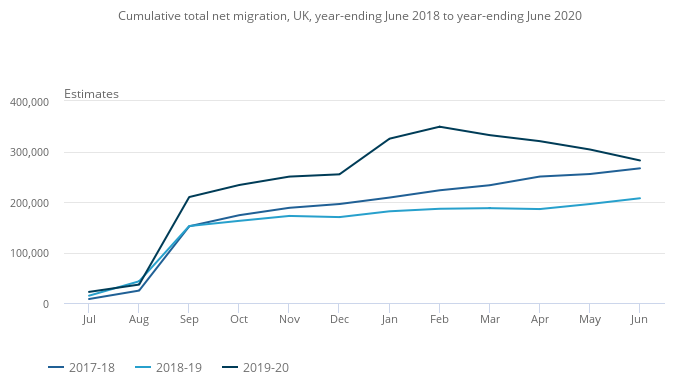An evolving picture of UK population change

During the pandemic, some of our usual methods for measuring population and migration have been either paused or seriously disrupted, leading to speculation on what changes may have happened. However, providing the best available evidence to make decisions has never been more important. Here Liz McKeown gives an update on how we have accelerated our migration statistics transformation plans and are able to give fresh insights into population change since COVID-19 began.
The coronavirus pandemic has created a number of challenges for measuring the labour market, population and migration. At the same time there is significant interest in what impact the pandemic has had on the number of people living and working in the UK.
Last month we published new analysis to shed further light on the number of non-UK nationals in work. Our initial analysis using HMRC data suggested much smaller changes in the number of non-UK nationals in employment, compared with what we had seen in the Labour Force Survey.
This, as we explained in our recent blog, might also indicate little overall change in the number of non-UK nationals resident in the UK at end 2020 compared with a year earlier. Today we are providing more information on the wider picture of migration and population.
We’ve now published an early indicator on the population of the UK for mid-2020 and a migration scenario-based indication of the population for end of 2020 using modelled migration estimates and provisional data on births and deaths.
Exploratory Analysis
Migration modelling uses International Passenger Survey data up to the start of the pandemic, in combination with more timely travel and border flow administrative data, to help us begin to measure changes for the period March to June 2020.
The 12 months leading up to year ending June 2020 were unprecedented in many respects, not least in terms of migration and international travel. Our exploratory analysis of available data sources highlights how traveller and migrant behaviours changed in the context of COVID-19. Added to this is the impact of Brexit and the new immigration system introduced in January 2021. It is hard to disentangle the impacts of COVID-19 and Brexit on migration and it may take a few years for migration to return to stable levels and new, presumably seasonal, patterns.

Cumulative total net migration followed a similar pattern in the years ending June 2018 and June 2019. The year ending June 2020 saw higher than average net migration until March 2020, largely driven by increased immigration and fewer departures by Non-EU nationals, after which it began to drop.
Net migration, largely driven by non-EU arrivals but also some British citizens coming home before the pandemic fully hit the UK, was higher than the historical average up to March 2020. Our latest analysis of international migration shows that, to mid-year 2020 net migration was around 282,000 – which largely reflects the pre-pandemic period. If we look specifically at the patterns following March 2020, we can see a notable change due to the impact of travel restrictions, with net migration for quarter 2 around -50,000 (this is the sum of the central modelled estimates of net migration for April, May and June 2020 ).
Taking this data into account, our preliminary analysis suggests the UK population grew to 67.1million by mid-2020 – a 0.5% annual increase from mid-2019 – marking one of the smallest increases seen in the context of historical trends. This reflects a higher number of deaths and a continued decrease in the number of births being offset by a higher level of net international migration.

This chart shows annual population change over time. Our 2020 indicator suggests a growth for the year of just 0.5%, one of the smallest increases seen in the context of historical trends.
But, given recent events, it’s also important to provide an indication of the potential size of the UK population for a more recent time point. We have therefore applied a measure to provide indicative insights into the population to December 2020. They are a form of a population projection based on a specific set of demographic assumptions to show what could happen if those assumptions were realised. Under a scenario of a net migration outflow of 100,000 in the six months to the end of 2020, the population of the UK would still be larger than in mid-2019.
It’s important to remember that these are early population indicators based on new methods. There is uncertainty and they will likely be subject to revision in the coming months, especially as more data becomes available. In this respect they do not represent official population estimates.
But what they do provide are the very latest insights on what happened to the population and migration since the pandemic, using available data and new methods.
Transforming migration statistics
Alongside this, we have continued our longer-term work to transform migration statistics and develop new Admin-Based Migration Estimates (ABMEs).
Historically, our key measure for how many people immigrated into or emigrated out of the UK, the International Passenger Survey (IPS), was paused in March 2020. Since then, we have accelerated our work to produce admin-based migration estimates (ABMEs), as outlined in a previous blog. This work offers a substantial change to previous methods and is still evolving. The Registration and Population Interaction Database (RAPID) provides a single coherent view of interactions across the breadth of benefits and earnings datasets for anyone with a National Insurance number (NINo). Using DWP, HMRC and Home Office data we have demonstrated how we can estimate migration patterns (rather than migration intentions the IPS is based on) between 2010 and March 2020.
The results from the latest ABMEs are not directly comparable to other releases today, given it uses different data and covers different time periods. However, it has been published to demonstrate our progress on our broader work and the modelling work will be incorporated once further, more disaggregated data, becomes available. They are a work in progress and should not be used as official migration statistics at this time.
What’s next…
Our immediate next steps will focus on refining these methods, extending our use of RAPID data to include UK nationals and working closely with the Home Office as data on EU nationals becomes available from their new migration system. We plan to publish a further ABME update later this year.
In July 2021, we are planning to revise the weights used for results from the Labour Force Survey, taking into account changes in the non-UK population from available administrative data. We will then subsequently publish our population of the UK by country of birth and nationality output.
In summer 2021 we will also publish the official mid-year population estimates for mid-2020. These will provide a detailed and geographically granular age and sex profile of the population. In spring 2022 we are planning the provisional release of Census 2021 data which will provide further detail on the population of England and Wales.
Across our work on labour market, population and migration statistics, we will continue to work closely with our colleagues across the Government Statistical Service to bring together all available data to deliver the best possible insights. Our work across these areas will continue to evolve as we bring in new data sources and develop our methods and approaches. We will continue to provide regular updates and are always keen to receive feedback please contact us at pop.info@ons.gov.uk with any comments.

Liz McKeown is Director of Public Policy Analysis and Co-lead for COVID-19 Analysis at the ONS